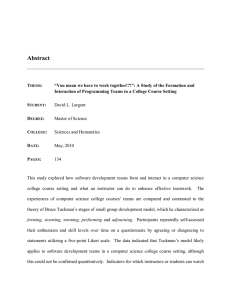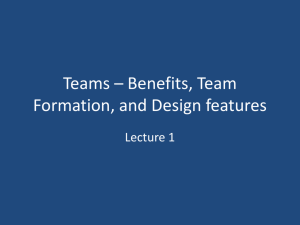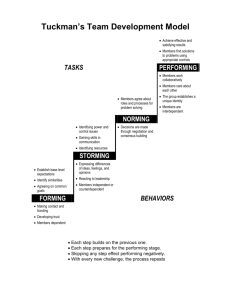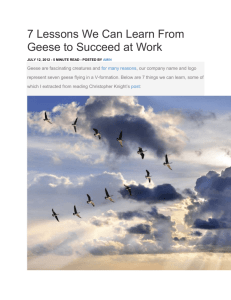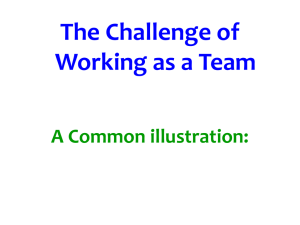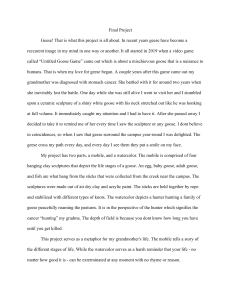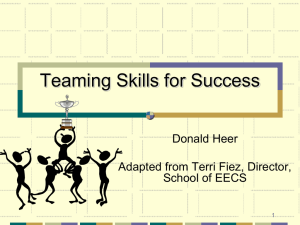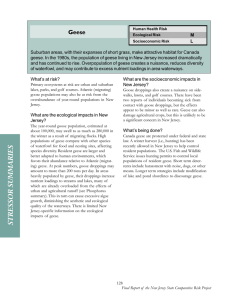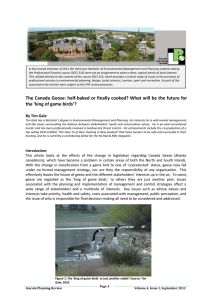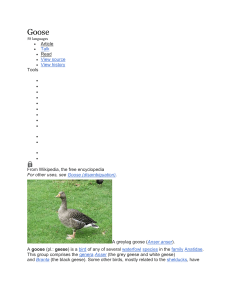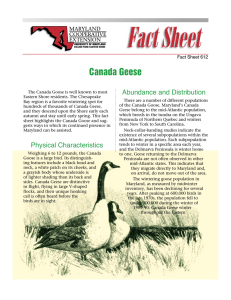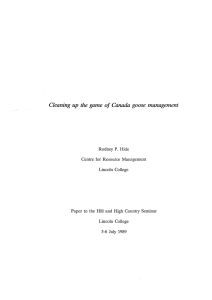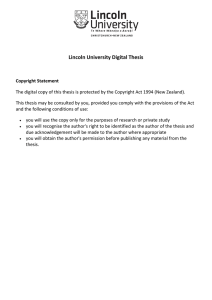A recipe for success Effective teams Kevin Hamer Learning and Development Centre
advertisement
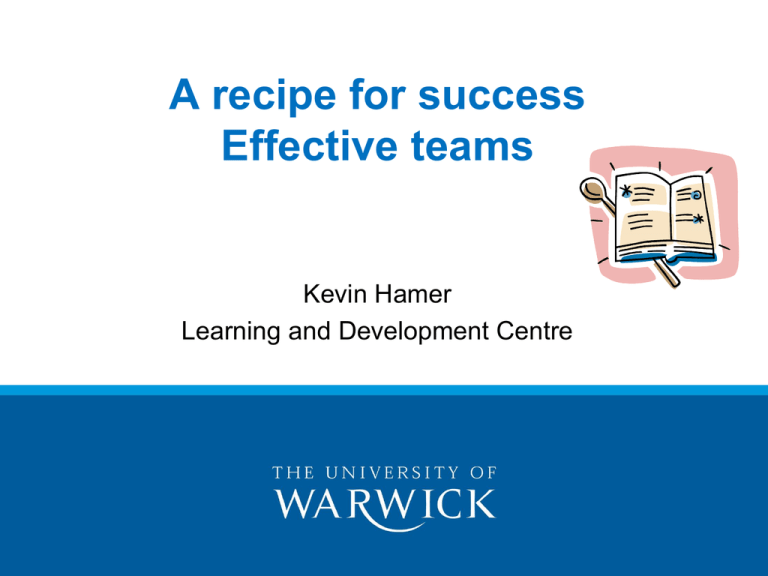
A recipe for success Effective teams Kevin Hamer Learning and Development Centre A bit of fun .... You have 5 minutes in your teams to list (in order) and ‘illustrate’ on flip-chart the: 12 days of Christmas! The ‘winning’ team gets a prize! The 12 days of Christmas ... • • • • • • • 12 Drummers Drumming 11 Pipers Piping 10 Lords-a-Leaping 9 Ladies Dancing 8 Maids-a-Milking 7 Swans-a-Swimming 6 Geese-a-Laying • • • • • 5 Gold Rings 4 Colly Birds 3 French Hens[8] 2 Turtle Doves And a Partridge in a Pear Tree. A recipe for success – overview • • • • • • • What do we mean by a team? Groups vs teams? Benefits of teams Characteristics of teams A couple of models about teams My own team and options for development Where to get more help Groups and Teams Group Team • Individuals with own purpose • Communication could be problematic • May not recognise others’ contributions • Belief in self • Common purpose • Ease of communication between individuals • Recognise and acknowledge everyone’s contribution • Belief in the team Teams – a definition ‘A team is a small number of people with complementary skills committed to a common purpose, performance goals and ways of working together for which they hold themselves mutually accountable.’ ( The Wisdom of Teams – Katzenbach & Smith) Typical benefits of teams • • • • • • • • • Organisational commitment Higher morale Greater creativity Job satisfaction Customer satisfaction Better decision making Synergy Less duplication Profit? Effective Teams – a recipe for success? • • • • • • • • • • • Key ingredients? Clear objectives and agreed goals Good communications Balanced roles Complementary skills/expertise Sound procedures Openness, confrontation and trust Cooperation and conflict Support for others Individual and team development Sound inter-group relations Appropriate leadership So what key role do you play in your team? Team Roles and Descriptions Belbin ® PLANT (PL) Creative; solves difficult problems TEAMWORKER (TW) Co-operative; averts friction RESOURCE INVESTIGATOR (RI) Enterprising; quick to explore opportunities IMPLEMENTER (IMP) Organised; efficient; practical CO-ORDINATOR (CO) Clarifies goals and promotes decision making COMPLETER FINISHER (CF) Painstaking; conscientious SHAPER (SH) Dynamic and challenging SPECIALIST (SP) Single-minded; professionally dedicated MONITOR EVALUATOR (ME) Discerning and objective Stages of Team Formation S E FORMING FORMING STORMING STORMING NORMING PERFORMING NORMING PERFORMING L F Inter R Independence E Counter dependence L I A N - dependence Dependence C E Time B.Tuckman, ‘Developmental Sequence in Small Groups’, Psychological Bulletin 63, 1965. Tuckman in practice- what will you see? Content and Process Issues Forming Storming • Need clarity on task • Clear direction • Deny task • Problems • Decisions voiced difficult • Develop • Resist demands processes made Feelings • Anxious • Express Issues • Unsure roles individuality • Polite and • ‘In-fighting’ cautious • Hierarchy concerns Norming • More accepting • More aware & comfortable Performing • Efficiency • Solve problems • ‘Achieve’ • Flexible •Team spirit • Effective communication • More flexible and efficient Where’s your own team currently? http://www.nwlink.com/~donclark/leader/teamsuv.html Consideration What are our roles as leaders/managers at each stage? Tuckman in practice- what can you do? Possible Leader Actions Forming Storming Norming Performing • Direct • Inform • Discuss how teams behave • Ensure team acquainted • Sensitive to needs • Act as role model • Clear Goals • Focus • Listen • Guide/support • Communication • Deal with conflict • Provide direct feedback • Enable • Facilitate • Processes • Coach - Listen • Encourage • Recognition • Review • Succession • New goals • Less involved - Questions - Feedback • Recognise achievement Teamwork - learning from Wildlife Lessons from Geese Lesson 1 - Goal Setting • As each goose flaps it’s wings, it creates an ‘uplift’ for the birds that follow. By flying in a ‘V’ formation, the whole flock adds 71% greater flying range than if each bird flew alone. • Lesson: People who share a common direction and sense of community can get where they are going more quickly and easily because they are travelling on the thrust of one another. Lesson 2 - Job Sharing • When a goose falls out of formation, it suddenly feels the drag and resistance of flying alone. It quickly moves back into formation to take advantage of the lifting power of the bird immediately in front of it. • Lesson: If we have as much sense as a goose, we stay in formation with those headed where we want to go. We are willing to accept their help and give it out to others. Lesson 3 - Leadership Sharing • When the lead goose tires, it rotates back into the formation and another goose flies to the point position. Lesson: • It pays to take turns doing the hard tasks and sharing leadership. As with geese, people are interdependent on each other’s skills, capabilities and unique arrangements of gifts, talents or resources. Lesson 4- Encouragement/recognition • The geese flying in formation honk to encourage those up front to keep up their speed. Lesson: • We need to make sure our honking is encouraging. In groups where there is encouragement the production is much greater. The power of encouragement( to stand by one’s heart or core values and to encourage the heart and core of others) is the quality of honking we seek. Lesson 5- Caring • When a goose gets sick, wounded or shot down, two geese drop out of formation and follow it down to help and protect it. They stay with it until it dies or is able to fly again. Then they launch out with another formation or catch up with the flock Lesson: • If we have as much sense as geese, we will stand by each other in difficult times as well as when we are strong. Teamwork - learning from Wildlife What might this mean for me? A recipe for success – overview • • • • • • • What do we mean by a team? Groups vs teams? Benefits of teams Characteristics of teams A couple of models about teams My own team and options for development Where to get more help Thanks for your time and input Any questions?
